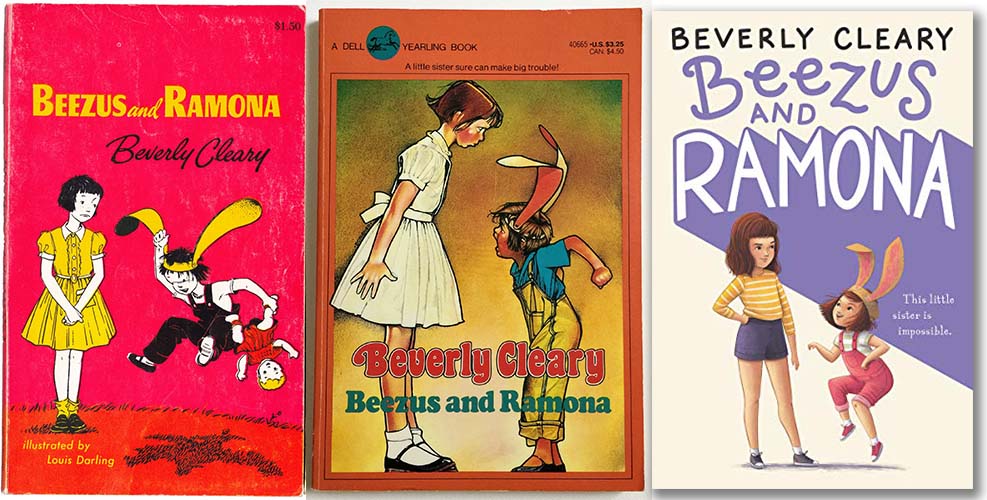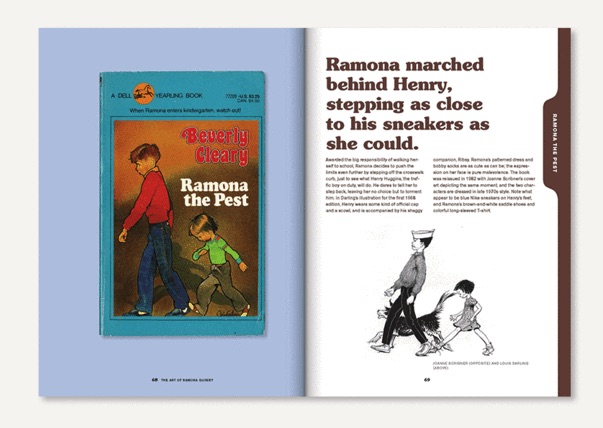I returned to Ramona Quimby for nostalgia. What I found was even better: a mystery.
Beloved Portland, Oregon author Beverly Cleary wrote the Ramona books over four decades, from Beezus and Ramona (1955) to Ramona’s World (1999). Set on leafy Klickitat Street in Portland, Oregon, the eight-book series follows the adventures of spunky Ramona Quimby, her sister Beezus (and, later, her baby sister Roberta), her cat Picky-picky, her parents, friends, and neighbors. Seeing images of Portland in tear gas, under an orange sky, I’ve felt enraged, terrified, and helpless. I’ve wanted to escape to Ramona’s Portland, with invisible lizards and makeshift sheep costumes and beloved red rubber boots.
And then, escapism turned into an enigma. Cleary writes in Ramona Quimby, Age 8, “Ramona had reached the age of demanding accuracy from everyone, even herself.” As it turns out, this isn’t exactly true. The Ramona series has many tiny pinpricks of the uncanny ––and each is a delight.
In Ramona and Her Father, the fourth book, the book opens with Mr. Quimby bringing home a little bag of candy as a present for Beezus and Ramona. “His daughters pounced and opened the bag together,” writes Cleary. “‘Gummybears!’ was their joyful cry. The chewy little bears were the most popular sweet at Glenwood School this fall. Last spring powdered Jell-O eaten from the package had been the fad. Mr. Quimby always remembers these things.”
But there’s something wonky in the state of Oregon. How does Ramona know what gummy bears are? Ramona and Her Father was published in 1977, but gummy bears didn’t hit American stores until at least 1981. In the 1920s, German factory worker Hans Riegel, founder of the candy company Haribo, produced the first bear-shaped gummy candies, and they quickly became a beloved confection in Riegel’s home country. In the sixties and seventies, military service members introduced the candies to their families, and German teachers started bringing the bears to American classrooms. But it wasn’t until the 1980s, when gummy bears started getting mass produced for the US, that they became a huge hit, inspiring TV shows (The Adventures of the Gummi Bears) and earworms (“The Gummy Bear Song”). So how were gummy bears the confection du jour popular in Portland, Oregon, in 1977? Ramona and Beezus aren’t in German class, and Mr. Quimby, who procures the candies for them, isn’t in the army—military service members were the other way American sourced gummies before the 1980s. Plus, the flavors are all wrong. They call the red bears “cinnamon,” which, as any Haribo (or Trolli, or Black Forest) fiend knows, is never the red flavor.
As Ramona and Beezus carefully organize the candies by color, they overhear their father and mother in a tense discussion, and they realize something is not right. The gummy bear scene marks the division between a fundamentally stable world and one that can wobble off its axis, with lasting repercussions. Mr. Quimby has lost his job, throwing him into the sort of funk that anyone who’s, say, been stuck in their house for six months can relate to: he listlessly pushes a vacuum around, smokes, stares at the television, and hovers over the phone, waiting for prospective employers to return his calls.
More unsolved details emerge. “Taxes are due in November,” Mrs. Quimby frets as she tries to calculate how the family can stretch the budget. Taxes are due in April; quarterly taxes are due in September or January. To what government do the Quimbys owe money? Eventually, much to the Quimby family’s relief, Ramona’s father gets a job at ShopRite Market. There’s no mystery in ShopRite’s timeline: the name “ShopRite” emerged in 1951, and hundreds of these stores exist. But ShopRite has only ever served six states: Connecticut, Delaware, Maryland New Jersey, New York, and Pennsylvania. So where does Ramona’s father work?

Images from The Art of Ramona Quimby, by Anna Katz (with illustrations by Louis Darling, Alan Tiegreen, Joanne Scribner, Tracy Dockray, and Jacqueline Rogers)
When we turn to the illustrations for the book, the incongruities multiply. Though Beezus and Ramona only age six years, over the course of the series, the author aged four decades while writing them, and the illustrators had to grapple with the balance of keeping Ramona accurate while making sure each decade’s young readers could still relate to her. As Anna Katz chronicles in her warm new book, The Art of Ramona Quimby (Chronicle Books, 2020), each of her illustrators presents a different Ramona aesthetic, from Louis Darling’s original jazzy pen-and-ink cartoons, to Alan Tiegreen’s scribble-inspired doodles, to Tracy Dockray’s grey watercolor shades, to Jacqueline Rogers’s fast sketchbook energy—not forgetting Joanne Scribner’s hyper-realistic resin-layered cover art. Details get updated: strolling ladies wear fifties-era tea dresses in Darling’s depiction and full-on athleisure in Rogers’s. So which Ramona is the real Ramona: a spiky-haired fifties toddler in dungarees, or a grinning nineties child in bangs and slogan T-shirts?
According to Cleary’s winsome autobiography, A Girl from Yamhill, Cleary wanted to write the kind of books that kids could see themselves in, so she told stories based on her own childhood. Cleary wrote to Darling in 1967, when he was working on Ramona the Pest, about kindergarten fashions: “Sashes are Out in kindergarten. Mean old boys yank them…Girls always wear dresses with bobby socks or sometimes knee socks…All boys in rain gear look exactly alike. They wear brown boots, yellow rain coats that are usually too long and the kind of rain hat that has a visor and comes down over the neck and has a sort of hlf[sic]-moon space from which they peer out like little animals looking out of burrows.” Though Ramona isn’t from any one particular time period, she has to feel real at the moment she’s being read, and to do that, even the smallest details have to ring true to her readers. So even though Ramona looks anachronistic in her newer iterations, it’s these very inaccuracies that make her all the more real.
My favorite Ramonas are the ones where we see her as she sees herself. Near the end of Ramona and Her Father, Tiegreen’s Ramona peers into a Christmas-tree bauble, and the portrait in a convex mirror gives us Ramona through Ramona’s eyes: distorted face, huge nostrils blooming at the center of the curved surface, exaggeratedly drooping eyes melting into her cheeks.
I slipped deep into my nostalgia, wishing that mysterious gummy bear precognition was still the weirdest thing going on in Oregon. But when I returned to Ramona’s world, I didn’t find the comforting bubble I craved from Klickitat Street. Instead, I discovered a Ramona I could easily picture grappling with 2020, just the way her illustrators have always brought her to new life for each generation. As Katz points out, Ramona has always been reimagined to meet her world. I pictured Mrs. Quimby sewing Ramona an ill-fitting mask out of some hideous leftover fabric scraps from the neighbors, making Ramona vow that she would scowl every time she had to wear it, even if no one could see her grimace. Mr. Quimby would be an essential worker, making the whole family terrified every morning. He might even have to quarantine in the new extra bedroom, prompting Ramona to start drawing the “Q” in “Quarantine” with cat ears and whiskers, the way she adorns her own initial.
Ramona taught us how to look for the weirdness in the everyday, and the everyday in the scariest moments. When she wears a particularly gruesome witch costume in Ramona the Pest (“the baddest witch in the world!,” she declares), she begins the day delighted with her anonymity, but ends terrified by the greatest fear of all: no one will know who she is. So, she carries a huge poster with her name on it, presumably beaming under the warty disguise. The mask itself isn’t scary—disappearing, anonymity, being forgotten, is what’s most frightening of all. When Ramona’s mother reveals her pregnancy in Ramona Forever, I remembered Ramona’s fear that she’d lose the limelight to the newborn, but what I didn’t remember was that Ramona actually does, albeit briefly, have to leave her family. Immediately after baby Roberta is born, Ramona isn’t allowed to see her mother in the hospital, because children under twelve might carry contagious diseases. Alone in the waiting room, Ramona starts to itch, working herself into a psychosomatic lather. A passing doctor proclaims she has “siblingitis” and writes her a prescription. Finally, Mr. Quimby emerges, reads the scrip, gives her a hug, and the itching disappears. Even in isolation, Ramona’s loved ones refuse to let her be forgotten—and neither will we.
Adrienne Raphel is the author of Thinking inside the Box: Adventures with Crosswords and the Puzzling People Who Can’t Live without Them.
from The Paris Review https://ift.tt/3hZQLvG


Comments
Post a Comment